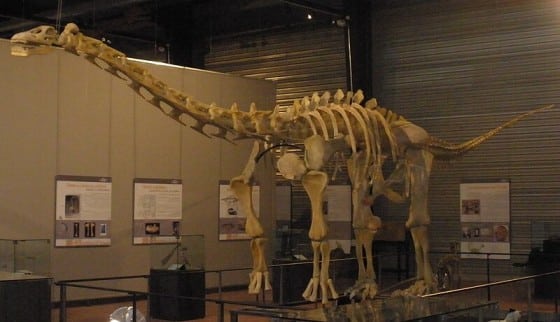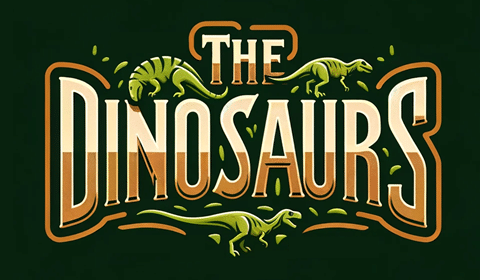Ampelosaurus atacis was a fascinating sauropod dinosaur that roamed what is modern day Europe during the Late Cretaceous period. Having been found in a region of France known for its vineyards, it led to its name, ampelos being Greek for vine.
Unique amongst sauropods for its distinct defensive adaptations, the Ampelosaurus is an excellent example of the diversity of evolution in the face of competition. This large herbivore, found in western Europe, showcases the variability between members of the sauropod family.
Key Facts
| Keyword | Fact |
|---|---|
| Ampelosaurus pronunciation | am-pel-oh-saw-ruhs |
| Meaning of name | Vineyard lizard |
| Group | Sauropod |
| Type Species | Ampelosaurus atacis |
| Diet | Herbivore |
| When it Lived | 83.5 to 66.0 MYA |
| Period | Late Cretaceous |
| Epoch | Late Campanian to Early/Lower Maastrichtian |
| Length | 49.0 to 52.0 ft |
| Height | 13.0 to 16.0 ft |
| Weight | Approx. 9 tons |
| Mobility | Moved on all four |
| First Discovery | 1989 by Jean Le Loeuff |
| Location of first find | Marnes Rouges Formation, France |
| First Described by | 1995 by Jean Le Loeuff |
| Holotype | MCCM-HUE-8741 |
Ampelosaurus Origins – Taxonomy, Timeline, and Discovery
The name Ampelosaurus, meaning “Vineyard Lizard”, is derived from the Greek word Ampelos for “vine” and sauros for “lizard”. A. atacis belongs to the Sauropod group. You will likely know the group for their long necks and tails and enormous size. It is a member of the Nemegtosauridae family within sauropoda, and its type species is Ampelosaurus atacis.
It lived in Europe during the Late Cretaceous period, specifically from the Late Campanian to the Early/Lower Maastrichtian epoch. This time range is approximately 83.5 to 66 million years ago, a time when the earth was undergoing significant changes, leading up to the extinction of the dinosaurs.
The first discovery of Ampelosaurus was made in 1989 by French paleontologist Jean Le Loeuff in the Marnes Rouges Formation, France. Le Loeuff also described the dinosaur for the first time in 1995, providing the scientific community with a detailed account of this fascinating creature. Its name was chosen due to the nearby Blanquette de Limoux vineyard of France.
Ampelosaurus has also been found in other locations within the Cretaceous period and these discoveries have further enriched our understanding of this dinosaur and the geographical range it inhabited.
Fossil Evidence

The first fossil evidence of Ampelosaurus from 1989 in France included fossils that were well-preserved and provided a wealth of information about this dinosaur and its lifestyle. Subsequent discoveries of Ampelosaurus fossils have been made in other locations within the Cretaceous period. Specifically, four additional sites in France and one in Spain have yielded Ampelosaurus fossils.
The fossils found include a great number of skeletal elements, providing a good understanding of the dinosaur’s physical characteristics and size. However, the degree of preservation varies between specimens, and some details about the Ampelosaurus remain unknown.
Ampelosaurus Size and Description
The Ampelosaurus was a large long-necked dinosaur, as shown by the fossil evidence. The size and appearance are typical of the Sauropod group, which includes some of the largest dinosaurs that ever lived.
Like most dinosaurs in that group, it was a quadrupedal dinosaur, moving on all four limbs. Its body was robust, with a long neck and tail, compared to its body. The head was relatively small, again like most sauropods, with a mouth equipped to graze on vegetation. Its limbs were strong and sturdy, designed to support the dinosaur’s significant weight.
Size and Weight of Type Species

This was a sizable creature with an estimated length of 49 to 52 feet. This size is based on the fossil evidence currently available, although it’s important to note that individual sizes could have varied. Based on the evidence we have today, the estimated weight of an adult would have been around nine tons.
The Dinosaur in Detail
In many ways, the Ampelosaurus resembled the rest of its sauropod relatives. One of its most distinctive features is its osteoderms, or ‘armour plating’. These bony structures provided a form of protection against predators, a feature not commonly found in sauropods. Thus, this adaptation suggests that the Ampelosaurus faced significant threats in its environment, leading to the evolution of this defensive mechanism.
It also had a unique dental structure, designed for an herbivorous diet. The teeth were adapted for grazing on vegetation, indicating that the dinosaur was likely a low browser, feeding on plants close to the ground despite its ability to reach plants higher up.
The Ampelosaurus in its Natural Habitat and Environment
It lived during the Late Cretaceous period, a time of significant change in the Earth’s climate and ecosystems. The environment it inhabited in western Europe was likely diverse, with a range of vegetation types to support its herbivorous diet.
Unlike many sauropods, its dental structure suggests that it was a low browser, grazing on vegetation close to the ground. However, its long neck would have allowed it to reach plants at various heights, providing it with a diverse diet when necessary.
It was a quadrupedal dinosaur, moving on all four limbs. This mode of locomotion would have allowed it to navigate its environment effectively, whether it was traversing open plains or moving through dense vegetation. The dinosaur’s size and strength may have also played a role in shaping its environment, as it could have easily cleared paths through vegetation or created depressions in the ground as it moved.
The social behavior of the Ampelosaurus is not well known, but it’s possible that it lived in herds for protection, as is common among many herbivore dinosaurs.
Interesting Points about Ampelosaurus
- It is one of the few sauropods known to have osteoderms. So called ‘armour plating’, providing it with a form of protection against predators.
- Despite being a large dinosaur, it had a relatively small head, a common feature among sauropods.
- It lived during the Late Cretaceous period, a time of significant change in the Earth’s climate and ecosystems near the end of the dinosaurs.
- The first fossils were discovered in France, but subsequent finds have also been made in Spain, indicating a wider distribution of this dinosaur in the Late Cretaceous.
- The name, meaning ‘Vineyard Lizard’, is a nod to the region where the dinosaur’s fossils were first discovered, known for its vineyards.
Contemporary Dinosaurs
The Ampelosaurus wasn’t the only European dinosaur roaming the land in the Late Cretaceous. Among its contemporaries were the Iguanodon, Lirainosaurus, and Telmatosaurus, each contributing to the intricate dynamics of their shared ecosystem.
For instance, the Iguanodon might have been a competitor for resources due to its herbivorous diet similar to the Ampelosaurus. These two could have found themselves vying for the same lush vegetation that flourished in their shared habitat. In contrast to the defensive osteoderms of the Ampelosaurus, the Iguanodon had thumb spikes to help it fend off its predators.
The Lirainosaurus and Telmatosaurus, on the other hand, were smaller in stature. These dinosaurs, while not as physically imposing as the Ampelosaurus, added to the diversity of life during this period. The Lirainosaurus, also with an elongated neck, might have grazed on vegetation out of reach for the Ampelosaurus. This would have reduced any direct competition. The Telmatosaurus, despite its smaller size, might have shared similar feeding grounds with the Ampelosaurus, leading to potential interactions and competition.
To sum up, this exploration paints a vivid picture of a world where these dinosaurs coexisted, each playing their part in the complex dance of survival. Therefore, with its contemporaries, it formed a unique ecosystem, a testament to the diverse and dynamic nature of prehistoric life.
Frequently Asked Questions
The name translates to “Vineyard Lizard”. It is derived from the Greek word for “vine” and the Latinized Greek term for “lizard”.
It lived during the Late Cretaceous period, specifically from the Late Campanian to the Early/Lower Maastrichtian epoch. This timeline places the dinosaur’s existence between 83.5 to 66 million years ago.
As an herbivore, it would have primarily fed on plants. Its dental structure suggests that it was a low browser, grazing on vegetation close to the ground.
The first fossils were discovered in the Marnes Rouges Formation, France. Subsequent finds have also been made in Spain.
One of the most distinctive features is its osteoderms, or ‘armour plating’. These bony structures provided a form of protection against predators, a feature not commonly found in sauropods.
It was a sizable creature, with an estimated length of 49 to 52 feet. However, the weight of the Ampelosaurus is challenging to estimate without more comprehensive fossil evidence.
Sources
- https://www.academia.edu/398452/Ampelosaurus_atacis_nov_gen_nov_sp_un_nouveau_Titanosauridae_Dinosauria_Sauropoda_du_Cr%C3%A9tac%C3%A9_sup%C3%A9rieur_de_la_Haute_Vall%C3%A9e_de_lAude_France_
- https://naturalhistory.si.edu/sites/default/files/media/translated_publications/LeLoeuff_95.pdf
- https://journals.plos.org/plosone/article?id=10.1371/journal.pone.0036907
- https://www.ncbi.nlm.nih.gov/pmc/articles/PMC3552955/
Featured Image Credit: ДиБгд at Russian Wikipedia, Public domain, via Wikimedia Commons
